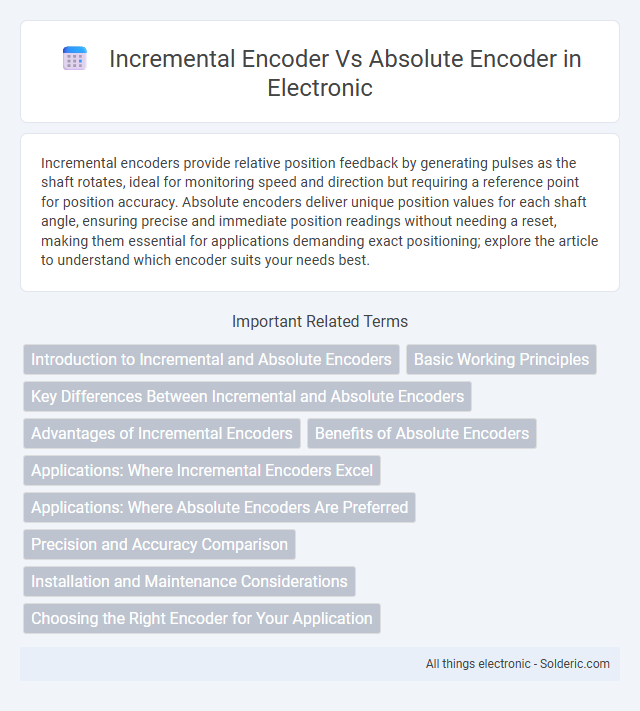Incremental encoders provide relative position feedback by generating pulses as the shaft rotates, ideal for monitoring speed and direction but requiring a reference point for position accuracy. Absolute encoders deliver unique position values for each shaft angle, ensuring precise and immediate position readings without needing a reset, making them essential for applications demanding exact positioning; explore the article to understand which encoder suits your needs best.
Comparison Table
| Feature | Incremental Encoder | Absolute Encoder |
|---|---|---|
| Output Type | Pulse signals indicating movement | Unique position code for each shaft angle |
| Position Tracking | Relative; requires reference point after power loss | Absolute; retains position after power cycles |
| Power Failure Impact | Position lost, needs re-homing | Position maintained, no re-homing needed |
| Resolution | High, depends on pulse count per revolution | High, depends on code unique states |
| Complexity | Simple, cost-effective | Complex, more expensive |
| Applications | Speed measurement, relative positioning | Precise angle measurement, robotic arms |
| Signal Interface | Quadrature signals (A & B channels) | Serial or parallel digital output |
| Installation | Easier alignment needed for pulses | More tolerant, immediate absolute position |
Introduction to Incremental and Absolute Encoders
Incremental encoders generate relative position signals by producing pulses as the shaft rotates, enabling measurement of speed and direction but requiring a reference point for absolute position. Absolute encoders provide unique position values for each shaft location using coded signals, allowing for immediate and precise position identification without needing a baseline. Both encoder types convert mechanical motion into electrical signals but serve distinct applications based on accuracy and initialization requirements.
Basic Working Principles
An incremental encoder generates pulses proportional to the movement, requiring a reference point to determine position, while an absolute encoder provides a unique digital code for each shaft position, ensuring precise location data without needing a reset. Incremental encoders measure changes in position by counting pulses, making them suitable for applications with continuous motion tracking. Your choice depends on whether you need relative movement data or exact position identification for system control.
Key Differences Between Incremental and Absolute Encoders
Incremental encoders generate relative position signals through pulses, requiring a reference point to determine absolute position, whereas absolute encoders provide unique position values directly via multi-bit digital outputs at any point of rotation. Incremental encoders are simpler and cost-effective with higher resolution options, while absolute encoders offer precise, crash-safe position feedback essential for applications demanding continuous position monitoring. The choice between these encoders depends on system requirements such as the need for zero-loss position tracking, complexity, and operational environment.
Advantages of Incremental Encoders
Incremental encoders offer simpler design and cost-effectiveness compared to absolute encoders, making them ideal for applications requiring speed and direction measurement without complex position tracking. They provide high-resolution feedback by generating pulses relative to movement, enabling precise control in robotics and motor feedback systems. Your system benefits from easy installation and maintenance, with adaptability to varying speeds and straightforward integration into digital control systems.
Benefits of Absolute Encoders
Absolute encoders provide precise position feedback with unique position values for each shaft angle, enabling accurate tracking even after power loss, unlike incremental encoders that rely on a reference point reset. They enhance system reliability by eliminating the need for homing procedures during startup, reducing downtime and improving operational efficiency in robotics and automation applications. Absolute encoders also support multi-turn counting, offering comprehensive position data critical for complex machinery control.
Applications: Where Incremental Encoders Excel
Incremental encoders excel in applications requiring precise speed and position feedback, such as CNC machines, robotics, and conveyor systems, where relative motion tracking is sufficient. Their simple design and cost-effectiveness make them ideal for high-speed monitoring and feedback control in industrial automation. These encoders are preferred in environments where system resets and homing processes are routine, enabling accurate incremental position calculation from a known reference point.
Applications: Where Absolute Encoders Are Preferred
Absolute encoders are preferred in applications requiring precise position tracking during power loss or system reset, such as robotics, CNC machines, and industrial automation. Their ability to provide unique position values without referencing a home point ensures reliable performance in complex motion control systems and safety-critical devices. This makes them ideal for use in automated assembly lines, medical equipment, and aerospace instrumentation where accuracy and data retention are paramount.
Precision and Accuracy Comparison
Incremental encoders offer high precision through relative position tracking with fine resolution pulses but require a reference point to establish accuracy after power loss. Absolute encoders provide inherent accuracy by delivering unique position values directly, ensuring precise position information throughout operation without needing recalibration. Your choice depends on whether consistent accuracy or real-time position reference is more critical for your application.
Installation and Maintenance Considerations
Incremental encoders require precise alignment during installation to ensure accurate pulse output and often need periodic recalibration, increasing maintenance efforts. Absolute encoders offer easier installation with built-in position reference and minimal calibration, reducing downtime and maintenance complexity. Both encoder types demand proper sealing and protection to maintain performance in harsh environments, with absolute encoders generally providing better reliability under variable conditions.
Choosing the Right Encoder for Your Application
Selecting the right encoder depends on the application's requirements for position accuracy and data retention; incremental encoders offer high-resolution relative position sensing ideal for speed and direction monitoring, while absolute encoders provide unique position values ensuring precise location tracking even after power loss. Incremental encoders are often preferred for applications needing fast, continuous feedback with simple count data, whereas absolute encoders suit scenarios demanding exact position identification and system reliability. Assessing factors such as environment, cost sensitivity, and motion complexity helps determine the optimal encoder type to enhance control performance and operational efficiency.
incremental encoder vs absolute encoder Infographic

 solderic.com
solderic.com